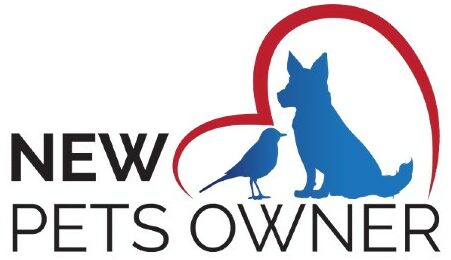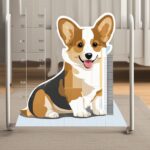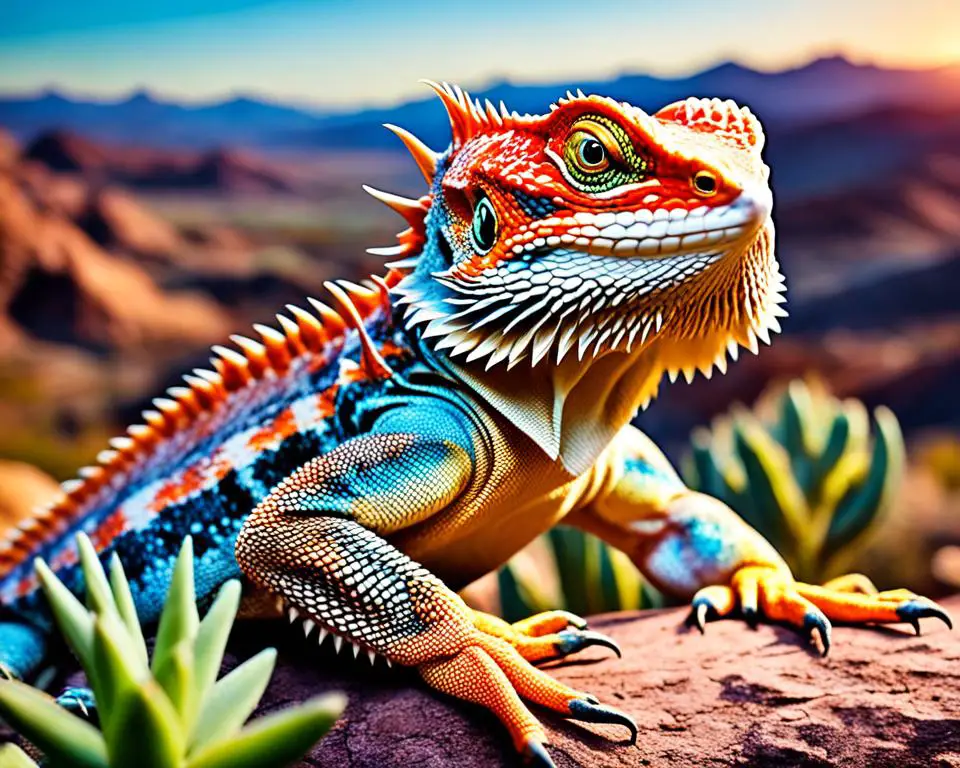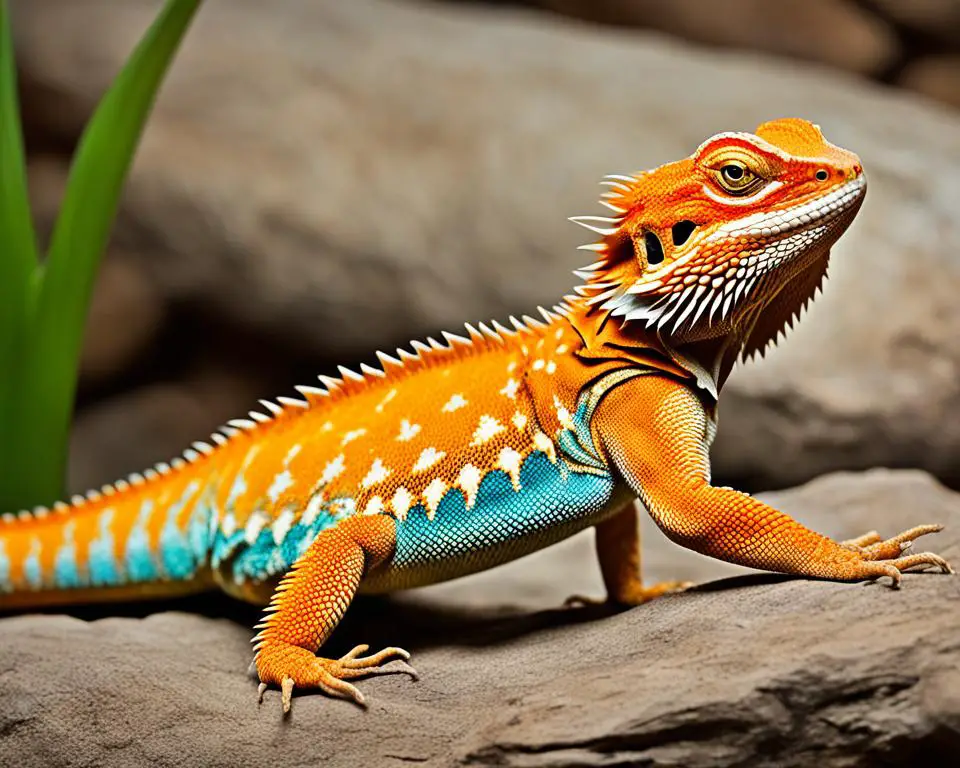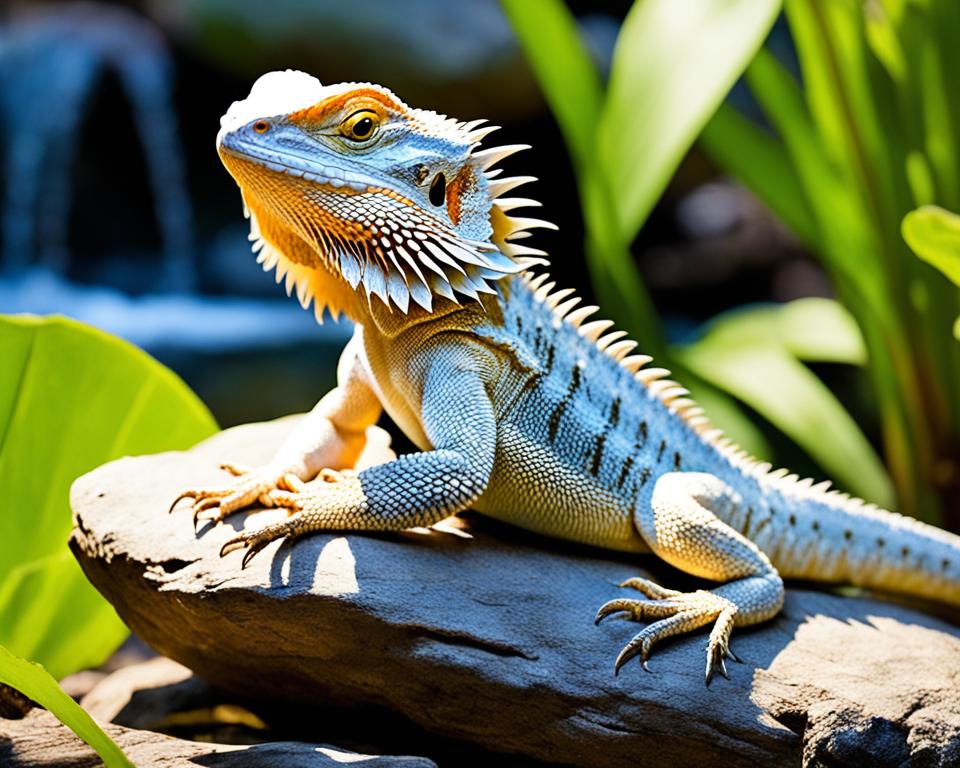Newborn bearded dragons, known as Pogona vitticeps, are fascinating reptiles from eastern and central Australia. They grow up to 18-24 inches long as adults. It’s vital to care for them properly for their health and growth.
Baby bearded dragons love to taste their surroundings, so it’s important to use safe substrates. They need a diet high in protein, different from adults. They also need special lighting and heating to grow right.
The basking spot for these young dragons should be 105-110 degrees Fahrenheit during the day. At night, it can be cooler, in the sixties. They need lights on a timer for 12-14 hours a day to match their natural day-night cycle. The cage should have humidity of 35%-55%.
Feeding them collard greens, mustard greens, and dandelion greens in small pieces is good for them. Also, giving them phosphorous-free calcium powder like RepCal with D3 every third to fourth feeding is key. Adding vitamins like Herptivite once a week is also important.
With proper care, bearded dragons can grow to over 14 inches in 4-5 months. Knowing how to care for them makes it fun to have one as a pet. It ensures they stay healthy and happy.
Selecting a Healthy Baby Bearded Dragon
Choosing a healthy baby bearded dragon is key to a long, happy life for your pet. This guide will show you what to look for in a healthy hatchling. It will also tell you where to find trusted bearded dragon breeders.
What to Look For
When picking bearded dragons, watch for their physical and behavioral signs. A healthy baby bearded dragon should have clear eyes, a clean vent, and a nose without discharge. These signs show good Baby Bearded Dragon Health.
Look for lively and active behavior. They should move around a lot, show curiosity, and explore their space. A healthy bearded dragon loves to climb and explore, showing they are full of life and well.
- Clear, bright eyes
- Clean vent and nose
- Active and alert behavior
- Good appetite for live prey
- Regular misting with room temperature water to prevent dehydration
These traits are important for your hatchling’s health and long life.
Where to Find Reputable Breeders
Finding trusted bearded dragon breeders is crucial for your pet’s health. Breeders who share medical records and do thorough interviews are usually the best. They should follow responsible practices and have a good hatchling selection guide.
They should give you lots of info on Baby Bearded Dragon Health. This includes what to feed them, how to set up their home, and how to handle them.
More people want baby bearded dragons because they’re great for beginners. If you’re getting one, choose breeders who care about ethics and keep the dragons healthy from start to finish. They should give them lots of light for 10-12 hours a day and keep the right heat, keeping them happy and healthy.
Setting Up the Perfect Terrarium
Creating a great home for your bearded dragon starts with the right terrarium setup. It’s important to make sure their home is comfy and safe. This helps them act naturally and stay healthy.
Choosing the Right Size Enclosure
Choosing the right size terrarium is key. For baby bearded dragons, a 120-gallon terrarium (48″L x 24″W x 24″H) is a good start. This size is big enough for temperature control and lets your dragon grow. Remember, bearded dragons like their space, so keep only one in each terrarium to prevent fighting and stress.
Substrates to Use
It’s important to pick the right substrate for your bearded dragon. For babies, use solid substrates like tile, Zen Mat, newspapers, or paper towels. These are safe because they don’t taste bad. Later, you can switch to natural substrates. But avoid sand or loose particles because they can cause health problems if eaten.
Terrarium Decorations and Enrichment
Adding the right decorations can really help your bearded dragon. Things like cork, hammocks, and fake plants make their home better. They help your dragon act naturally and feel less stressed. These items also give them places to hide, climb, and bask.
By following these tips for setting up your terrarium, you’ll make a great home for your bearded dragon. The right size, substrate, and decorations mean a happy and healthy pet. They’ll love exploring and enjoying their new space.
Lighting and Heating Requirements
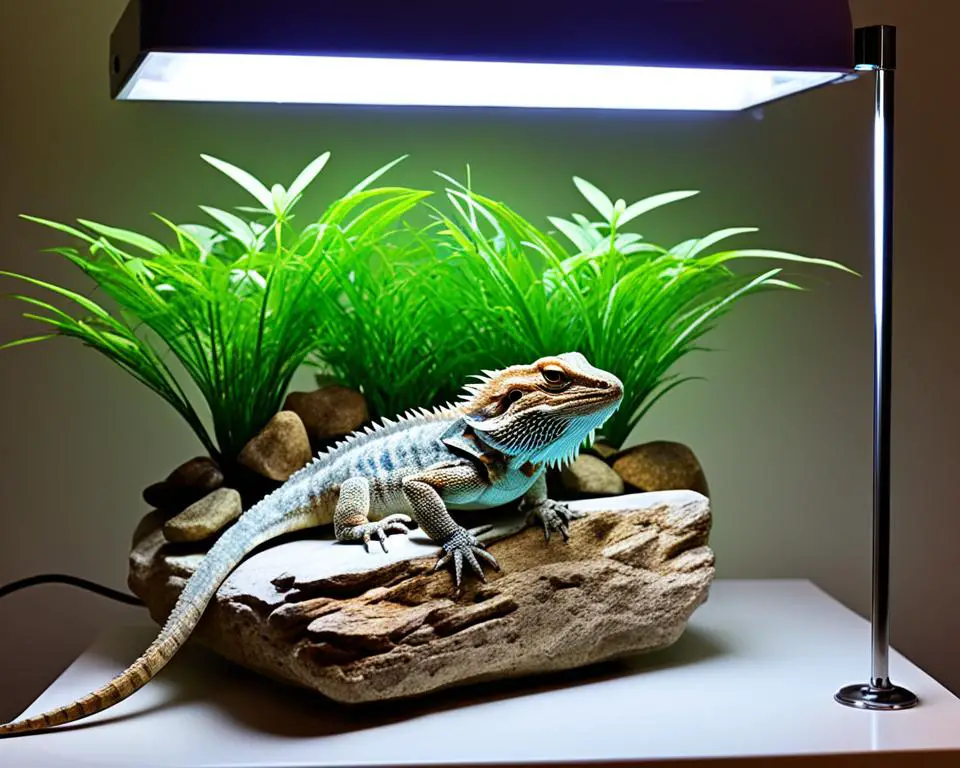
Understanding your bearded dragon’s UVB lighting and heating needs is key to their health. Let’s explore how to create a perfect environment for your pet.
UVB Lighting
UVB light is crucial for bearded dragons as it helps make vitamin D3, which is important for bone health. Without enough UVB light, bearded dragons can get Metabolic Bone Disease. A great option is the Arcadia T5 bulbs with a 14% UV index.
Place these bulbs 14-15 inches above the basking spot for best results. For a standard 4-foot vivarium, a 12% T5 bulb is best. Remember to replace UVB lights every 10-12 months for the best performance.
Keep them on for 10-12 hours in winter and 14-16 hours in summer. This helps maintain a natural day-night cycle.
Temperature Gradient
Creating a proper temperature gradient is essential for your bearded dragon’s health. The basking spot should be between 105-115°F during the day. The cooler end should be around 70-85°F.
Start with a 100W halogen heat lamp, but adjust as needed based on your setup’s temperature. It’s important to have a night-time temperature drop to around 60°F. This mimics their natural environment.
In colder months or areas with low temperatures, you might need extra heat. Use ceramic heat emitters or red night bulbs if necessary.
Feeding Your Bearded Dragon
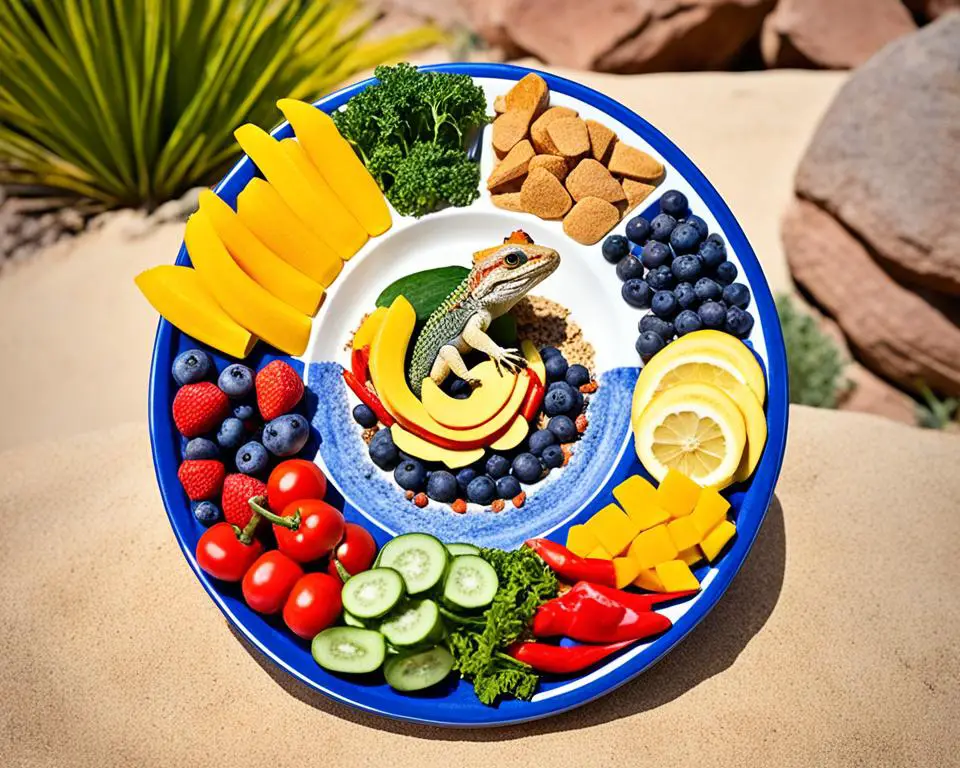
The diet of a Bearded Dragon is crucial for its health and happiness. It’s important to know what they need from the start. This helps them grow strong and live a long life.
Types of Feeder Insects
For young bearded dragons, insects like crickets and Dubia roaches are great choices. Make sure they are small to prevent choking. Offer them several times a day. But, give waxworms and “superworms” only a little because they are high in fat.
Frequency and Amount of Feeding
It’s important to feed your baby dragon often. Hatchlings and young dragons need to eat two to three times a day. Let them eat as much as they can in a 10-15 minute session. This helps them grow fast because they need a lot of protein.
Including Vegetables in the Diet
Insects are the main food, but adding vegetables is also key. Start giving them leafy greens early for hydration and more nutrition. Cut these into small pieces so they’re easy to eat. As they get older, give them more vegetables, making up to 80% of their diet by 12-18 months.
Importance of Calcium and Vitamins
To meet their needs, add supplements to their diet. Dust their insects with calcium powder without phosphorus every day. Also, give them vitamin D3 supplements. But, use multivitamins carefully to avoid giving too much.
| Age | Diet Composition | Feeding Frequency |
|---|---|---|
| Hatchling (0-5 months) | 80% insects, 20% vegetables | 2-3 times per day |
| Juvenile (6-12 months) | 50% insects, 50% vegetables | 2 times per day |
| Adult (12+ months) | 20% insects, 80% vegetables | Daily or thrice weekly |
Understanding and following these dietary guidelines will keep your bearded dragon healthy and happy. With proper care and regular vet check-ups, you can ensure they thrive at every stage of their life.
Handling Your Newborn Bearded Dragon
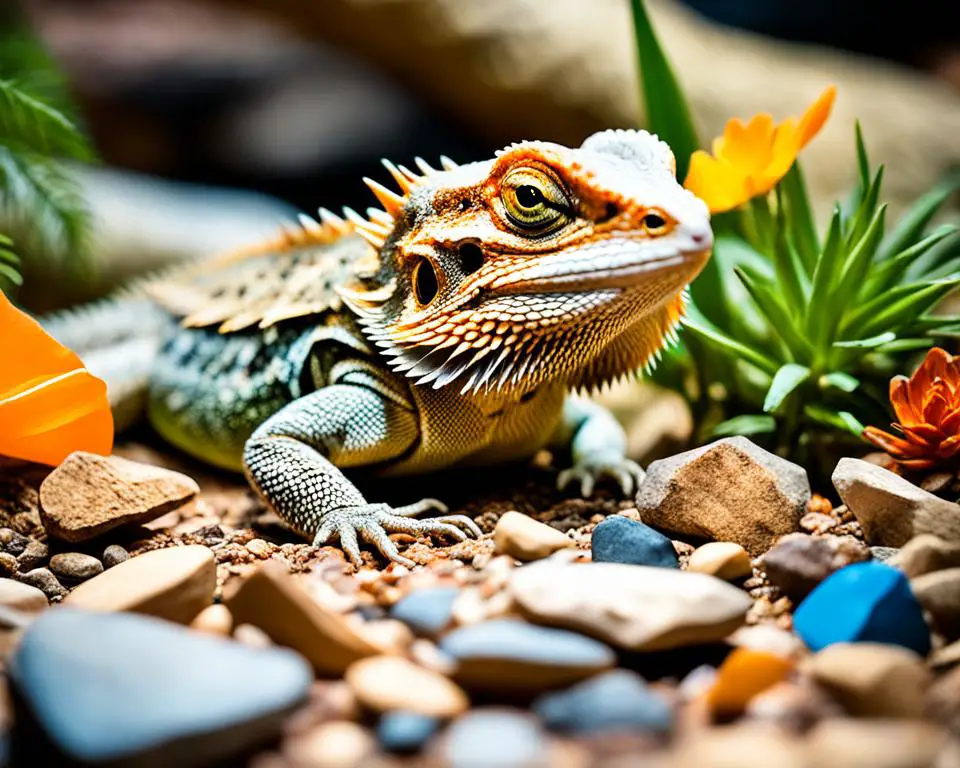
Handling your newborn bearded dragon needs patience for a good Bearded Dragon Socialization. Wait about two weeks before starting any big human interaction. This time is key for their adjustment and reduces stress.
Getting Them Used to Human Interaction
After your baby dragon feels at home, start socializing them. Put your hand in the enclosure slowly without sudden moves. This helps your dragon get used to your smell and presence. Over time, your dragon will see you as a comfort, not a threat.
Handling Techniques to Avoid Stress
For Stress-Free Handling, use gentle moves. Move slowly and scoop from underneath for support. Don’t grab from above, as it might make your dragon feel threatened. Start with short handling times, up to 10-15 minutes a day, and slowly increase as they get used to it.
Regular, gentle handling is key for taming your baby dragon. It builds a strong bond between you. This approach makes taming smoother and helps you have a healthy, interactive relationship.
Check out a Reptile Interaction Guide for more tips on a strong, stress-free bond with your bearded dragon.
Monitoring Health and Growth
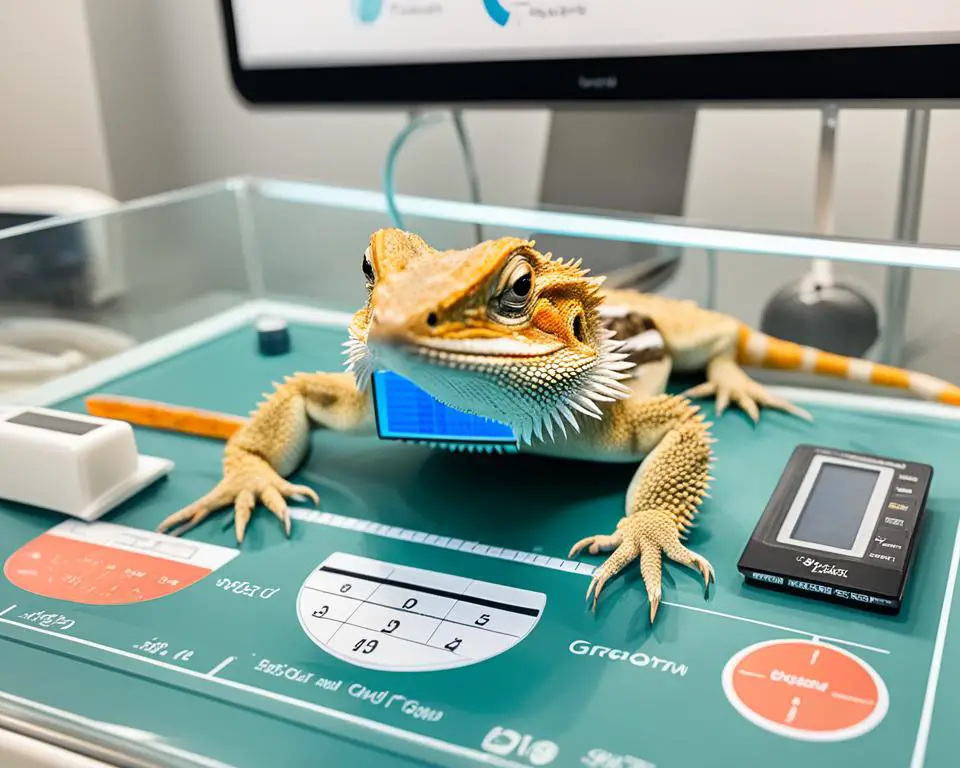
Watching your bearded dragon’s health and growth closely is key for a long and happy life, which can last 8–10 years. Keeping track of their growth helps spot early *Signs of Healthy Development*. Newborn bearded dragons grow fast, especially in the first year, which shows they are doing well.
It’s a good idea to weigh your baby bearded dragon once a week to check on their growth and health. This is a key part of Reptile Health Monitoring. Adult bearded dragons can grow up to 24 inches long, with half of that being their tail. Watching their weight and length helps spot problems early and makes sure they grow right.
Feeding them the right mix is also crucial. Young bearded dragons need 70% insects and 30% veggies, fruits, and treats for growth. Adding fresh greens as they get older is a good idea. For a detailed feeding plan, check out this Reptile Health Monitoring guide.
Watching their behavior, appetite, and waste is also important. These can tell you a lot about their health. Eating well and having regular, healthy waste are good signs they are doing well.
How they live is also key. They need a big enough enclosure, the right temperature, and safe UVB light to avoid burns. Juveniles need a 20-gallon tank, while adults need at least 40 gallons. Getting a 75-gallon tank is often best for their growth. For tips on setting up their home, see Bearded Dragon Growth Tracking.
Monitoring their health also means keeping their home stress-free. They need at least two places to hide in their tank to control their temperature and stress. Their home should have a warm spot of about 100 F and the right humidity, between 30% and 50%.
By watching these things, owners can help their dragons grow strong and live a long life, up to 18 years for the oldest ones.
Temperature and Humidity Control
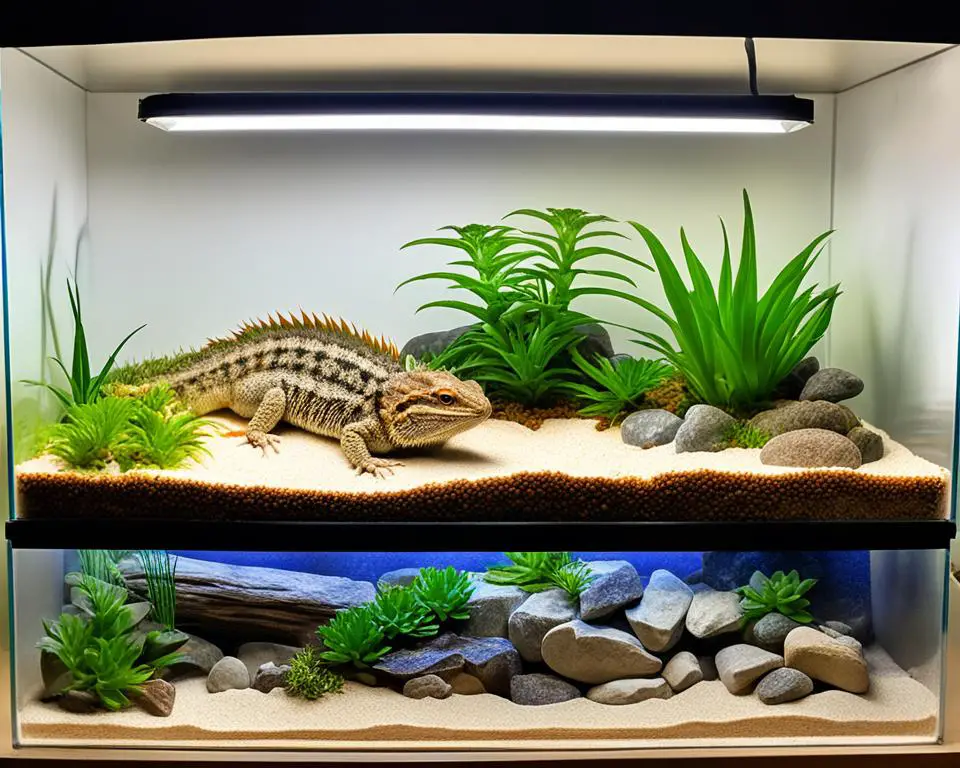
Keeping a stable environment in the terrarium is crucial for a newborn bearded dragon’s health. It’s important to control both temperature and humidity levels. This ensures healthy growth and prevents health problems.
Ideal Temperature Ranges
For Bearded Dragon Temperature Control, the right temperature is key. A basking spot of 108-113°F (42-45°C) on one side of the enclosure is best. For baby dragons (0-6 months), keep it between 95-110°F (35-43°C).
Juvenile dragons (6-12 months) need a basking spot of about 95-100°F (35-38°C). Adults (1+ years) prefer a slightly cooler spot of 90-93°F (32-34°C).
The cool side should be 70-85°F (21-29°C). To cool the tank, use fans, mist it, offer cool water for bathing, raise the heating lamp, and adjust the dimmer. This creates a natural temperature gradient like in the wild.
At night, keep the temperature between 65-75°F (18-24°C). This mimics the natural drop in temperature at night.
Maintaining Proper Humidity Levels
Keeping the Ideal Humidity for Reptiles in the terrarium is vital. Aim for a humidity level of 30-40%. A digital probe hygrometer can help monitor this accurately on the cool side.
High humidity can lead to respiratory problems and other health issues. Thermal Regulation in Terrariums means balancing temperature and humidity. This ensures a safe and comfortable home for your bearded dragon.
| Age | Basking Temp (°F) | Cool Side Temp (°F) | Humidity Level (%) |
|---|---|---|---|
| Baby (0-6 months) | 95-110 | 70-85 | 30-40 |
| Juvenile (6-12 months) | 95-100 | 70-85 | 30-40 |
| Adult (1+ years) | 90-93 | 70-85 | 30-40 |
Preventing and Treating Common Health Issues
It’s important to take care of your Bearded Dragon’s health before problems start. Make sure their diet, the stuff they walk on, and their living space are clean. This helps avoid digestive problems like impaction.
Feeding your bearded dragon a mix of leafy greens, veggies, and fruits is key. Young ones need extra calcium three times a week. Adults should get calcium and vitamins once a week. Seeing a vet regularly can spot problems early and keep your dragon healthy.
Common Reptile Illnesses like metabolic bone disease, coccidiosis, and eye problems can happen if you’re not careful. Make sure your dragon gets enough UVB light and keep the humidity right to stop these issues.
Handling your bearded dragon often can make them calm and used to it. Cleaning their tank regularly helps too. Remove poop, old food, and dirty bedding to stop bacteria like Salmonella.
- Impaction: Avoid it by picking the right walking stuff and feeding them right.
- Metabolic Bone Disease: Make sure they get enough UVB light and eat foods with calcium.
- Eye Problems: Keep their home clean and the air just right.
Seeing a veterinary care for lizards often is a must. Find a vet who knows about reptiles. They can give you advice and treatment that fits your dragon’s needs.
Dealing with health issues early means your bearded dragon can live a long, healthy life. Keeping their living space and food right helps stop common reptile illnesses. This is key for your dragon’s health.
Decorating the Terrarium for Mental Stimulation
Creating a fun environment for your bearded dragon is key to their happiness and mental health. Using Bearded Dragon Terrarium Design ideas is crucial. Adding different decorations helps keep your pet active and mentally sharp.
Decorations like basking rocks and logs let your dragon bask and regulate their temperature. Hides, burrows, and caves give them places to hide, just like in the wild. Adding live plants like air plants and agave brings in natural textures and colors.
Items like bones and foam decorations enrich the environment and look good. But, be careful with hammocks as they can trap your dragon’s nails or limbs. Using fabric hammocks with no big holes is safer, but make sure to clean them often.
To keep decorations safe, bake them at 200-250 degrees for 30 minutes or disinfect them with a vet-approved cleaner. This stops harmful germs from getting into the terrarium.
Here’s a list of must-have decorations for bearded dragon terrariums:
| Decoration Item | Usage | Safety Tips |
|---|---|---|
| Basking Rocks/Logs | Elevated surfaces for basking | Ensure stability to prevent tipping |
| Hides/Burrows/Caves | Provides hiding spaces | Avoid sharp edges |
| Live Plants | Natural ambiance and foliage | Use non-toxic varieties |
| Foam Decorations | Visual enrichment | Select durable, non-toxic materials |
| Hammocks | Climbing and rest | Opt for fabric types; clean regularly |
| Backgrounds | Naturalistic or themed visuals | Ensure easy cleaning and maintenance |
Changing the terrarium layout often keeps things fresh for your bearded dragon. Using wild habitat photos can inspire you to create a Decor for Dragon Enclosures that encourages natural behavior and reduces stress.
Adding enrichment items is crucial for bearded dragon care. A well-thought-out setup with new items keeps your pet engaged and happy. This helps their overall health and well-being.
Common Mistakes to Avoid in Bearded Dragon Care
Raising a healthy Bearded Dragon takes ongoing care and prevention. Avoid buying them on impulse from pet stores or reptile expos. It’s crucial to research and prepare a proper habitat before bringing one home. Bearded Dragons are very sensitive to their environment.
Creating a bad reptile habitat is a common error. Baby Bearded Dragons need a place with different temperatures and humidity levels. They grow fast, so a big enclosure is best from the start. This saves time and money later.
Not providing the right lighting is another mistake. UVB lighting is key for their health. The wrong lighting can cause serious health problems. Pet store staff often suggest the wrong products, which can harm your reptile.
Choosing the wrong substrate is dangerous. Sand can cause death from blockages. Use paper towels, reptile carpets, or tile instead. These are safer for your dragon.
Ignoring your dragon’s diet is a big mistake. They need a mix of insects and leafy greens. Leafy greens are vital for their health. Too many vitamins or calcium can be harmful.
Knowing these mistakes helps you care for your Bearded Dragon better. Providing the right care and adjusting as needed keeps them happy and healthy. This brings peace of mind to you too.
Conclusion
As we conclude our guide on caring for newborn bearded dragons, remember, it’s all about a detailed approach. Choosing a healthy hatchling, setting up a great terrarium, and providing the right lighting and heat are key. Eggs hatch in 60 to 75 days, bringing you into the world of bearded dragon parenting.
It’s crucial to know what they eat. Feed them small insects 2-3 times a day, along with dark leafy greens for moisture and nutrients. Use ‘small’ crickets and dubia roaches, but watch out for leftover feeders in their space. UV bulbs lose their effectiveness, so replace them to help with growth and sunning.
Keep an eye on their health, handle them gently when they settle in, and keep their home just right. Don’t forget calcium and vitamin D3 supplements for their fast growth and to prevent deficiencies. Following these tips and watching their health closely will create a great home for your bearded dragon. These final thoughts on caring for hatchlings will make your journey with them both rewarding and fulfilling.
Source Links
- Baby Bearded Dragon Care Sheet – Dachiu Bearded Dragons
- Basic Baby Bearded Dragon Care?
- Bearded Dragons – Care Sheet
- TIPS FOR RAISING BABY BEARDED DRAGONS IN CAPTIVITY
- Baby Bearded Dragon: Interesting Facts, Habitat — Animallearns
- Baby Bearded Dragon Care Guide | Zen Habitats
- Bearded Dragon Tank Setup 101: How to Create the Best Home for Your Ne
- The Proper Way to Set Up a Bearded Dragon Enclosure
- Lighting & heating Bearded Dragon
- bearded dragon night time heating
- What set up do I need for my Bearded Dragon? – ExoticDirect
- How To Care For Baby Bearded Dragons | Petbarn
- How Often Do Bearded Dragons Eat? Feeding Chart by Age
- Feeding Bearded Dragons | VCA Animal Hospitals
- TIPS FOR RAISING BABY BEARDED DRAGONS IN CAPTIVITY
- Baby Bearded Dragon Care: Beginner Care Guide 2023
- Hatchling Care
- Bearded Dragon Care Sheet
- Baby Bearded Dragons | Top 5 Must Know Tips
- Bearded Dragon Care 101
- Bearded Dragon Lighting, Heating & Humidity Requirements
- Bearded Dragon Temperature & Humidity: The Ideal Level Guide
- What Temperature Should Bearded Dragon Tank Be?
- Bearded Dragon Care
- What to Know About Bearded Dragons
- Bearded Dragon Care Guide | Long Island Avian and Exotic Vet Clinic
- Options for Bearded Dragon Decorations & Enrichment
- The Best Bearded Dragon Enclosures for Your Pet
- Bearded Dragon Complete Lighting and Heating Guide
- 10 Baby Bearded Dragon Care Mistakes New Owners Usually Make…
- How to Handle a Bearded Dragon: Do’s and Don’ts | PetSmart
- Bearded Dragon (Detailed Care Guide)
- What to Expect When You’re Expecting: Baby Bearded Dragon Care – August 2013
- New bearded dragon closing eyes?
- REPRODUCTIVE BIOLOGY OF BEARDED DRAGONS
